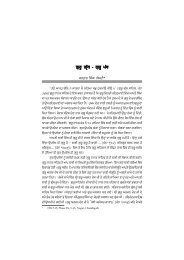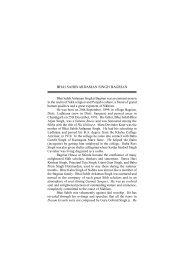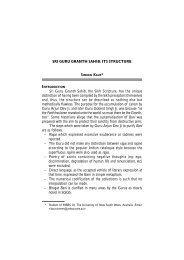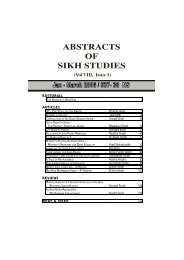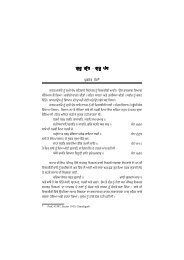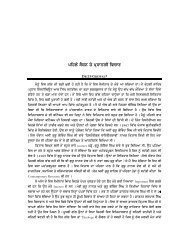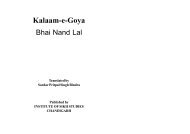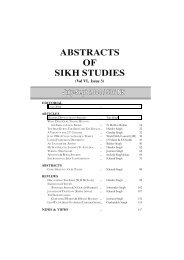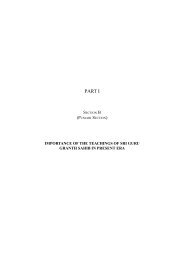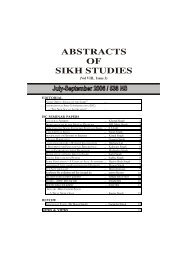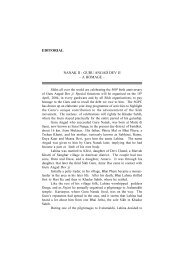editorial articles reviews news & views - Institute of Sikh Studies
editorial articles reviews news & views - Institute of Sikh Studies
editorial articles reviews news & views - Institute of Sikh Studies
Create successful ePaper yourself
Turn your PDF publications into a flip-book with our unique Google optimized e-Paper software.
MCLEOD & FENECH AS SCHOLARS ON SIKHISM AND MARTYRDOM<br />
79<br />
Bhagat Singh or Udham Singh. He would certainly have been<br />
acclaimed as a martyr from Indian viewpoint even if India had<br />
continued as a British Colony for another fifty years !<br />
Fenech thereafter narrates <strong>Sikh</strong> Ardas rejoicing martyrdoms, but<br />
maliciously observers that these were “intended to magnify the heroism<br />
<strong>of</strong> those who stoically died these deaths.” Fenech brings in “popular<br />
art” and “bazar poster” as a means to depict 18th century <strong>Sikh</strong> martyrs,<br />
especially Baba Dip Singh. He is aware <strong>of</strong> the work <strong>of</strong> S. Kirpal Singh<br />
who drew various paintings, including that <strong>of</strong> Bhai Mani Singh, in<br />
1950s, showing “Khalsa fearlessness, bravery, loyalty, and endurance.”<br />
This was motivated by an oral tradition, which did influence Bhagat<br />
Lakshman Singh’s work, The <strong>Sikh</strong> Martyrs, published as early as 1923.<br />
He mentions numerous works since published to draw two conclusions.<br />
One, “such interpretations have gained a much firmer foothold since<br />
the events <strong>of</strong> 1984,” and, two, “an attempt albeit an unconscious one,<br />
at charhdi kala, to uplift and inspire <strong>Sikh</strong>s and non-<strong>Sikh</strong>s in this current<br />
time <strong>of</strong> crises” Both those conclusions to Fenech seem farfetched and<br />
irrelevant. Similarly, his mention about “Sanatan Singh Sabha <strong>of</strong><br />
Lahore” seems inapt while his talk <strong>of</strong> “the descendants <strong>of</strong> the Gurus,”<br />
enjoining <strong>Sikh</strong>s to view the Panth as simply “one among the many<br />
panths which make up the Hindu mosaic”, to say the least is a highly<br />
stupid interpretation imposed upon the author by the Indian intelligence<br />
set-up. His talk <strong>of</strong> baptismal water (amrit) prepared by the doubleedged<br />
sword (Khanda), at initiation ceremony (pahul), “believed to have<br />
originated with the tenth Guru” is highly suspect and demeaning to<br />
Fenech himself. The attempt to misinterpret is quite glaring.<br />
V<br />
As stated earlier, the first paragraph <strong>of</strong> chapter III, “Popular <strong>Sikh</strong><br />
Martyr Tradition: Theology and Personnel”, contradicts the opening<br />
lines <strong>of</strong> Chapter I <strong>of</strong> the thesis.<br />
The second para <strong>of</strong> chapter III starts with the author’s conducting<br />
a series <strong>of</strong> inter<strong>views</strong> near Batala in 1980s before coming to the howler,<br />
and one <strong>of</strong> the most stupid statements made in the thesis. “According<br />
to the inter<strong>views</strong>, the struggles the Panth underwent and the<br />
persecution to which its members were subjected since the seventeenth



